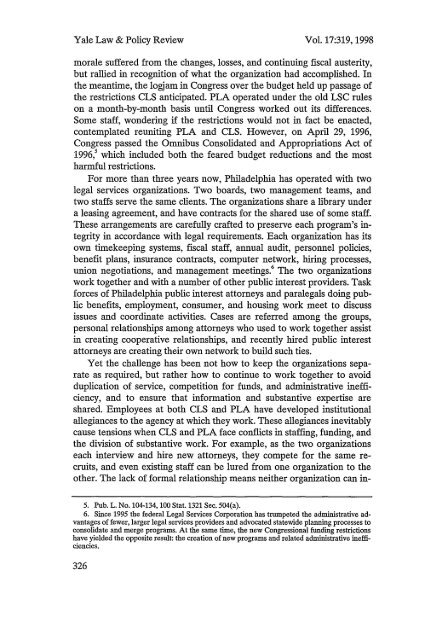Law for The Poor
Law for The Poor
Law for The Poor
Create successful ePaper yourself
Turn your PDF publications into a flip-book with our unique Google optimized e-Paper software.
Yale <strong>Law</strong> & Policy Review<br />
Vol. 17:319,1998<br />
morale suffered from the changes, losses, and continuing fiscal austerity,<br />
but rallied in recognition of what the organization had accomplished. In<br />
the meantime, the logjam in Congress over the budget held up passage of<br />
the restrictions CLS anticipated. PLA operated under the old LSC rules<br />
on a month-by-month basis until Congress worked out its differences.<br />
Some staff, wondering if the restrictions would not in fact be enacted,<br />
contemplated reuniting PLA and CLS. However, on April 29, 1996,<br />
Congress passed the Omnibus Consolidated and Appropriations Act of<br />
1996, 5 which included both the feared budget reductions and the most<br />
harmful restrictions.<br />
For more than three years now, Philadelphia has operated with two<br />
legal services organizations. Two boards, two management teams, and<br />
two staffs serve the same clients. <strong>The</strong> organizations share a library under<br />
a leasing agreement, and have contracts <strong>for</strong> the shared use of some staff.<br />
<strong>The</strong>se arrangements are carefully crafted to preserve each program's integrity<br />
in accordance with legal requirements. Each organization has its<br />
own timekeeping systems, fiscal staff, annual audit, personnel policies,<br />
benefit plans, insurance contracts, computer network, hiring processes,<br />
union negotiations, and management meetings. 6 <strong>The</strong> two organizations<br />
work together and with a number of other public interest providers. Task<br />
<strong>for</strong>ces of Philadelphia public interest attorneys and paralegals doing public<br />
benefits, employment, consumer, and housing work meet to discuss<br />
issues and coordinate activities. Cases are referred among the groups,<br />
personal relationships among attorneys who used to work together assist<br />
in creating cooperative relationships, and recently hired public interest<br />
attorneys are creating their own network to build such ties.<br />
Yet the challenge has been not how to keep the organizations separate<br />
as required, but rather how to continue to work together to avoid<br />
duplication of service, competition <strong>for</strong> funds, and administrative inefficiency,<br />
and to ensure that in<strong>for</strong>mation and substantive expertise are<br />
shared. Employees at both CLS and PLA have developed institutional<br />
allegiances to the agency at which they work. <strong>The</strong>se allegiances inevitably<br />
cause tensions when CLS and PLA face conflicts in staffing, funding, and<br />
the division of substantive work. For example, as the two organizations<br />
each interview and hire new attorneys, they compete <strong>for</strong> the same recruits,<br />
and even existing staff can be lured from one organization to the<br />
other. <strong>The</strong> lack of <strong>for</strong>mal relationship means neither organization can in-<br />
5. Pub. L. No. 104-134, 100 Stat. 1321 See. 504(a).<br />
6. Since 1995 the federal Legal Services Corporation has trumpeted the administrative advantages<br />
of fewer, larger legal services providers and advocated statewide planning processes to<br />
consolidate and merge programs. At the same time, the new Congressional funding restrictions<br />
have yielded the opposite result: the creation of new programs and related administrative inefficiencies.

















